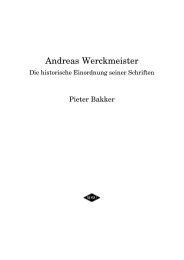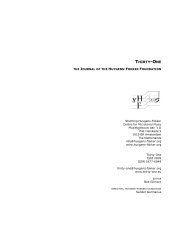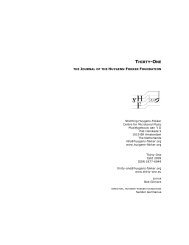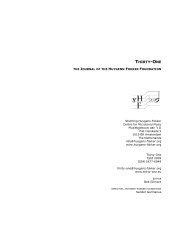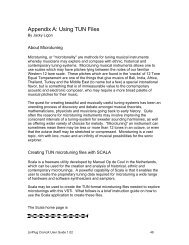Recent Organ Design Innovations and the 21st-century - Stichting ...
Recent Organ Design Innovations and the 21st-century - Stichting ...
Recent Organ Design Innovations and the 21st-century - Stichting ...
Create successful ePaper yourself
Turn your PDF publications into a flip-book with our unique Google optimized e-Paper software.
III. Kegelübersetzung: adjusts <strong>the</strong> key-to-pallet ratio from 1:2 to 5:1 using a variable fulcrum under<br />
<strong>the</strong> backfalls of <strong>the</strong> conical transmission.<br />
IV. Kegel an – ab: couples <strong>the</strong> cone action to <strong>the</strong> tail-pallet action, allowing cone action activation at<br />
variable key depth though intermediate settings.<br />
In addition, a flat beam containing springs can be mounted under <strong>the</strong> keyboard to correspond<br />
with <strong>the</strong> cone-pallet coupler setting. By setting <strong>the</strong> wind pressure of <strong>the</strong> cone-pallet chest somewhat<br />
higher than that of <strong>the</strong> tail chest, <strong>and</strong> carefully adjusting <strong>the</strong> cone action transmission ratio along with a<br />
delayed coupler action, one can obtain <strong>the</strong> flexible bebung effect so sought after by Daniel Glaus <strong>and</strong><br />
<strong>the</strong> research group. This effect results from <strong>the</strong> rapid variation of wind pressure as <strong>the</strong> finger engages<br />
<strong>and</strong> releases <strong>the</strong> cone-pallet, creating vibrato in both pitch <strong>and</strong> dynamics. The optional springs under<br />
<strong>the</strong> keyboard can be set so as to provide resistance to <strong>the</strong> key at <strong>the</strong> point where <strong>the</strong> cone action<br />
engages <strong>the</strong> tail action. Recognizing <strong>the</strong> potential pitfall of <strong>the</strong> expressive cone action (organists tend to<br />
find a complete lack of pluck or point of sound onset disconcerting), <strong>the</strong> builders included this artificial<br />
haptic mechanism to allow more natural control of expressive effects, simulating <strong>the</strong> increased<br />
resistance in <strong>the</strong> string of a clavichord when depressed beyond initial impact.<br />
While <strong>the</strong> dual wind system <strong>and</strong> variable mechanical properties of <strong>the</strong> key action allow<br />
unprecedented control over dynamics <strong>and</strong> tuning using only <strong>the</strong> motion of <strong>the</strong> finger, <strong>the</strong> widely<br />
variable wind pressure also reveals <strong>the</strong> diverse acoustic properties of <strong>the</strong> pipes <strong>the</strong>mselves. Three metal<br />
ranks of differing scales were chosen to examine <strong>the</strong> effects of varying wind pressure dynamics: a wide<br />
8’ Flute, a normal width 4’ Principal, <strong>and</strong> a very narrow 8’ Quintade which overblows at <strong>the</strong> quint at <strong>the</strong><br />
tail-pallet box’s 42 mm WC. 27 The Flute <strong>and</strong> Principal jump an octave at high pressures, while <strong>the</strong><br />
27 Ibid., 73.<br />
22



